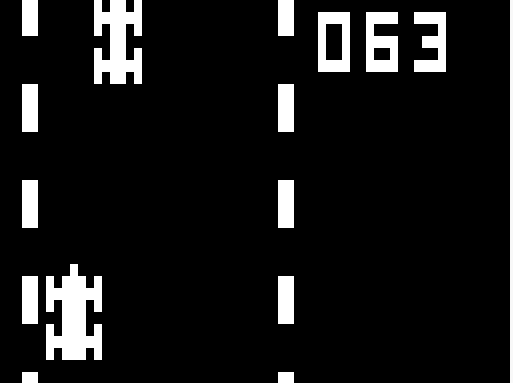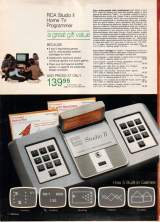
Studio II © 1977 RCA.
An early cartridge based videogame console in black and white graphics.
It had 5 built-in games: Doodle, Patterns, Bowling, Freeway, Addition.
Doodle: A simple program that allows the user to draw (doodle) on the screen. There is a cursor and the user can move it in 8 different directions, deciding whether it should paint or erase pixels on the screen.
Patterns: Another drawing program, this time enabling the user to create a doodle that can be infinitely repeated on screen by the system, inverting all the pixels it comes across in the process and generating unexpected patterns. If the user launches the program after drawing with Doodle first, the patterns are drawn on top of the original doodle.
Bowling: A simplistic top-down rendition of bowling for (exactly) two players. The ball moves automatically up and down the lane and the players just need to choose when to throw it. There are 3 different throws: straight, hook down, and hook up. After 10 frames are played, the final scores are shown and the game ends.
Freeway: A racing game where the player drives a car in a straight freeway and must steer to avoid collisions with other cars. Accidents will only slow the player down, but this has a great impact on the score as the goal is to make the best mileage within 2 minutes.
Addition: A math educational game for one or two players. The goal is to simply add 3 digits that show up on the screen simultaneously and press the according button on the keyboard. In a two player game, the player that hits the correct button first wins the round. The game ends after 20 rounds.
RCA 1802 microprocessor, 1.78 MHz
2 KB ROM (includes the five built-in games
512 bytes RAM
RCA CDP1861 "Pixie" video chip, 64x32, monochrome graphics
Released in the US in January 1977. Other games were released on programmable cartridges (11 in total).
As Fairchild already released its console as first with programmable cartridges late 1976, the Studio II was rushed to the market. That possibly explains the shortcomings such as the lack of colored graphics which Fairchild's system did possess. But some other shortcomings led to a quick demise of the Studio II.
The sound was through a single channel "Pong" style beeper housed in the system itself. The controllers were also built in the machine (undetachable).
The console did not sell well and production ceased in February 1978. With Atari releasing its VCS late 1977 in color and with much better graphics, RCA could not compete any more.
The Studio II was cloned by several non-American companies released in Europe, Australia and Japan.
Soundic MPT-02 Victory
Hanimex MPT-02
Mustang 9016 Telespiel Computer
Conic M-1200
Sheen 1200 Micro Computer
Trevi 1200 Micro Computer
Academy Apollo 80
Toshiba Visicom COM-100
These clones had color graphics and detachable controllers. Except for the Visicom these clones are all referred to as the RCA Studio III. In fact RCA had the plans ready for the Studio III but decided to sell the intellectual rights to the Conic Group who released the system in various countries under different brands.
The Visicom is thus the only true RCA Studio II clone.
Some of the games were designed by Joyce Weisbecker (the Studio II designer's daughter) becoming the first female programmer of commercial videogames.
Cartridge list:
"TV Arcade I: Space War [Model 18V400]"
"TV Arcade II: Fun with Numbers [Model 18V401]"
"TV Arcade III: Tennis/Squash [Model 18V402]"
"TV Arcade IV: Baseball [Model 18V403]"
"TV Arcade Series: Speedway/Tag [Model 18V404]"
"TV Arcade Series: Gunfighter & Moonship Battle [Model 18V405]"
"TV School House I [Model 18V500]"
"TV School House II: Math Fun [Model 18V501]"
"TV Casino I: Blackjack [Model 18V600]"
"TV Casino Series: TV Bingo [Model 18V601]" (very limited release)
"TV Mystic Series: Biorhythm [Model 18V700]"

Designed by: Joseph Weisbecker